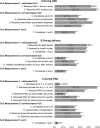The coverage of continuum of care in maternal, newborn and child health: a cross-sectional study of woman-child pairs in Ghana
- PMID: 30233827
- PMCID: PMC6135430
- DOI: 10.1136/bmjgh-2018-000786
The coverage of continuum of care in maternal, newborn and child health: a cross-sectional study of woman-child pairs in Ghana
Abstract
Introduction: The continuum of care has recently received attention in maternal, newborn and child health. It can be an effective policy framework to ensure that every woman and child receives timely and appropriate services throughout the continuum. However, a commonly used measurement does not evaluate if a pair of woman and child complies with the continuum of care. This study assessed the continuum of care based on two measurements: continuous visits to health facilities (measurement 1) and receiving key components of services (measurement 2). It also explored individual-level and area-level factors associated with the continuum of care achievement and then investigated how the continuum of care differed across areas.
Methods: In this cross-sectional study in Ghana in 2013, the continuum of care achievement and other characteristics of 1401 pairs of randomly selected women and children were collected. Multilevel logistic regression was used to estimate the factors associated with the continuum of care and its divergence across 22 areas.
Results: Throughout the pregnancy, delivery and post-delivery stages, 7.9% of women and children achieved the continuum of care through continuous visits to health facilities (measurement 1). Meanwhile, 10.3% achieved the continuum of care by receiving all key components of maternal, newborn and child health services (measurement 2). Only 1.8% of them achieved it under both measurements. Women and children from wealthier households were more likely to achieve the continuum of care under both measurements. Women's education and complications were associated with higher continuum of care services-based achievement. Variance of a random intercept was larger in the continuum of care services-based model than the visit-based model.
Conclusions: Most women and children failed to achieve the continuum of care in maternal, newborn and child health. Those who consistently visited health facilities did not necessarily receive key components of services.
Keywords: child health; community-based survey; cross-sectional survey; health services research; maternal health.
Conflict of interest statement
Competing interests: None declared.
Figures


References
-
- WHO, UNICEF, UNFPA, the World Bank, the United Nations Population Division. Trends in maternal mortality: 1990 to 2015. Geneva, Switzerland: World Health Organization, 2015.
-
- The United Nations Inter-agency Group for Child Mortality Estimation. Levels and trends in child mortality report 2015. New York, USA: United Nations Children’s Fund, 2015.
-
- The Partnership for Maternal, Newborn & Child Health. A global review of the key interventions related to reproductive, maternal, newborn and child health (RMNCH). Geneva, Switzerland: PMNCH, 2011.
LinkOut - more resources
Full Text Sources
Other Literature Sources
